Competitive Strategy Analysis Report: Commonwealth Bank of Australia
VerifiedAdded on 2022/09/21
|9
|1824
|22
Report
AI Summary
This report provides a comprehensive analysis of the competitive strategy employed by the Commonwealth Bank of Australia (CBA). It begins with an introduction to business strategy and its importance in achieving organizational goals. The report then delves into a SWOT analysis of CBA, evaluating its strengths, weaknesses, opportunities, and threats, providing insights into its internal and external environments. Following this, the report applies Porter's Five Forces framework to assess the competitive dynamics within the Australian retail banking industry, examining the rivalry among existing competitors, the threat of substitutes, the threat of new entrants, and the bargaining power of buyers and suppliers. Finally, the report explores Porter's generic strategies, focusing on the cost leadership strategy adopted by CBA. The analysis highlights CBA's strategic positioning and provides a conclusion summarizing the key findings and the significance of strategic planning for the bank's long-term success, referencing the provided sources.
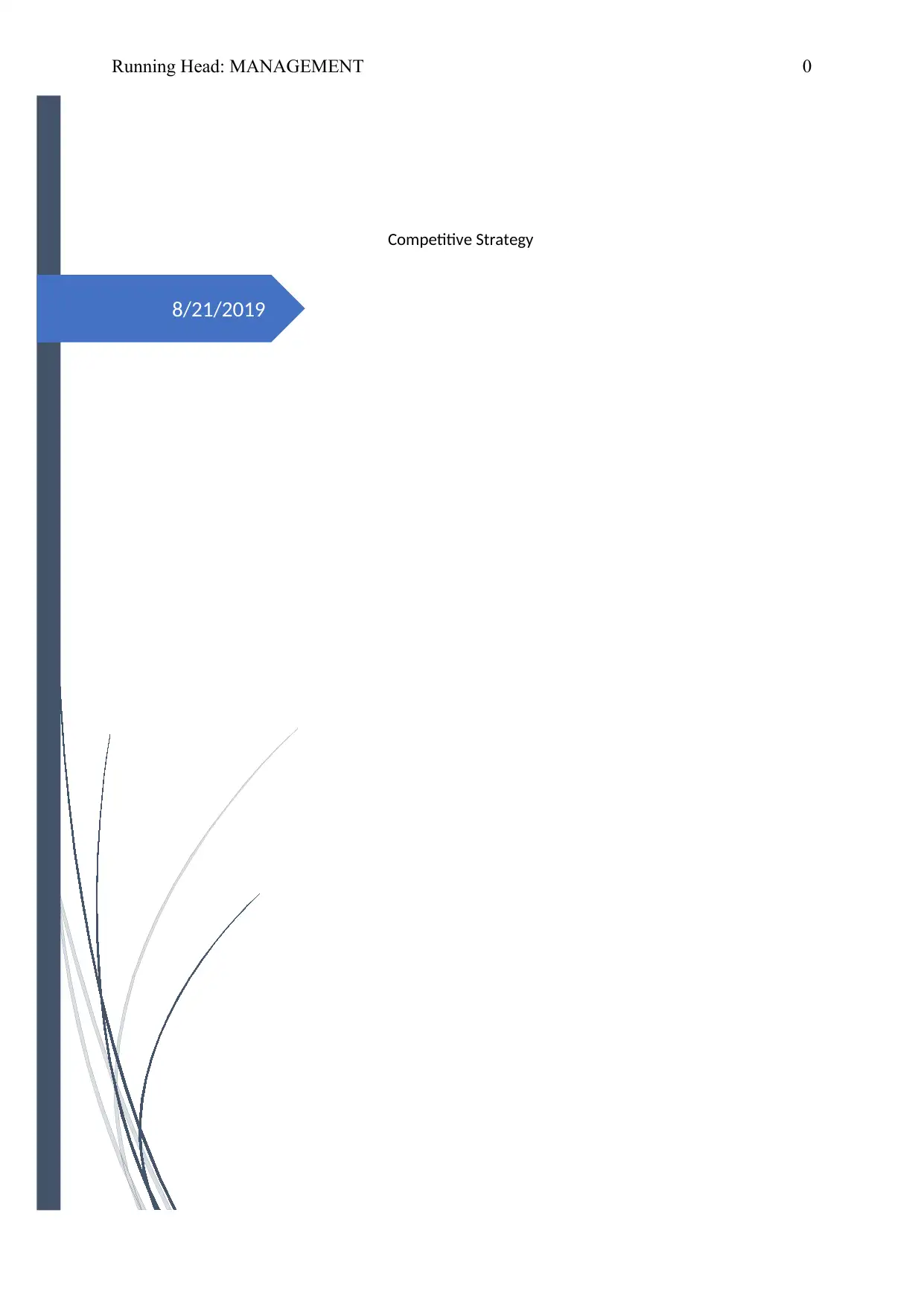
8/21/2019
Running Head: MANAGEMENT 0
Competitive Strategy
Running Head: MANAGEMENT 0
Competitive Strategy
Paraphrase This Document
Need a fresh take? Get an instant paraphrase of this document with our AI Paraphraser
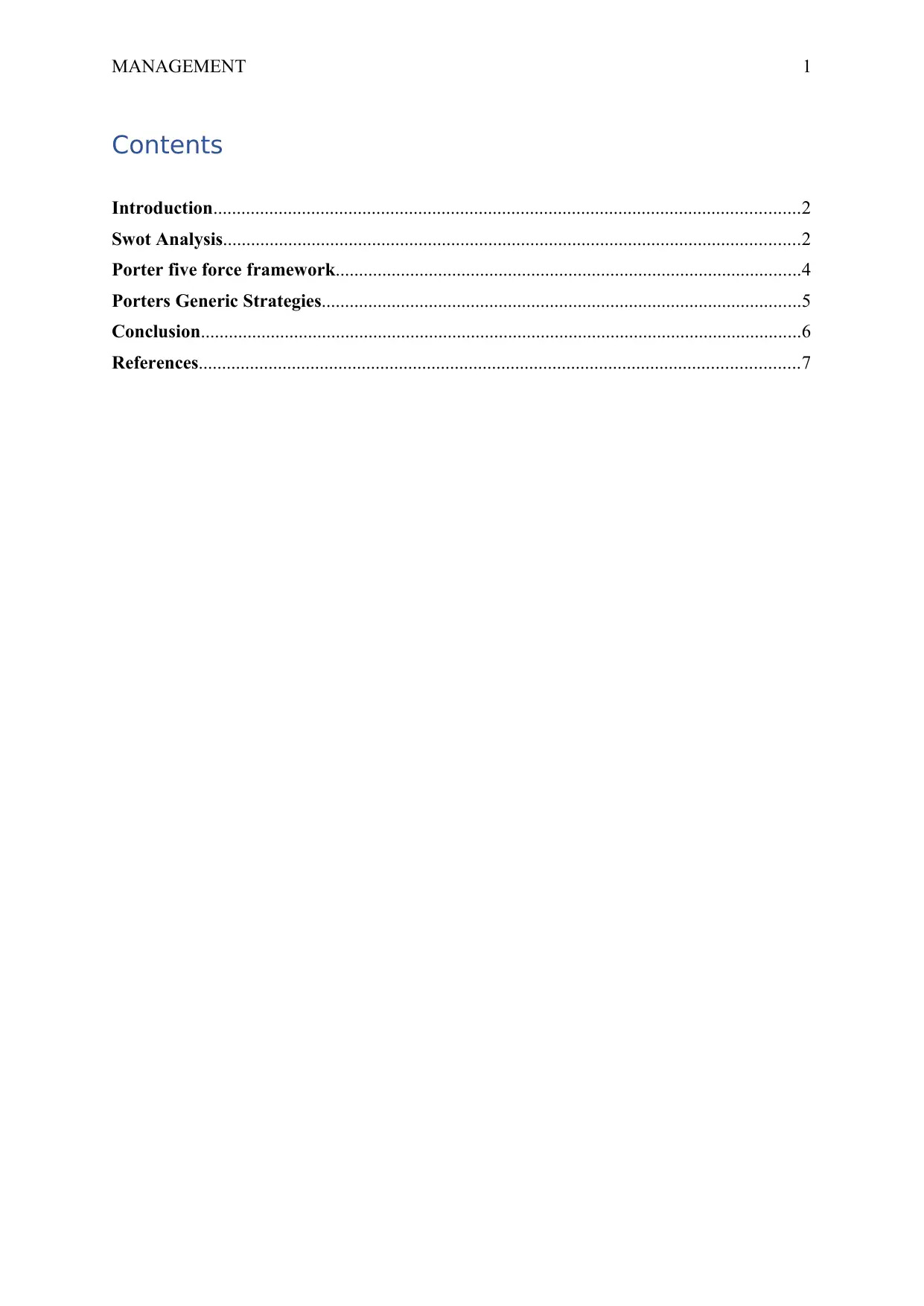
MANAGEMENT 1
Contents
Introduction..............................................................................................................................2
Swot Analysis............................................................................................................................2
Porter five force framework....................................................................................................4
Porters Generic Strategies.......................................................................................................5
Conclusion.................................................................................................................................6
References.................................................................................................................................7
Contents
Introduction..............................................................................................................................2
Swot Analysis............................................................................................................................2
Porter five force framework....................................................................................................4
Porters Generic Strategies.......................................................................................................5
Conclusion.................................................................................................................................6
References.................................................................................................................................7
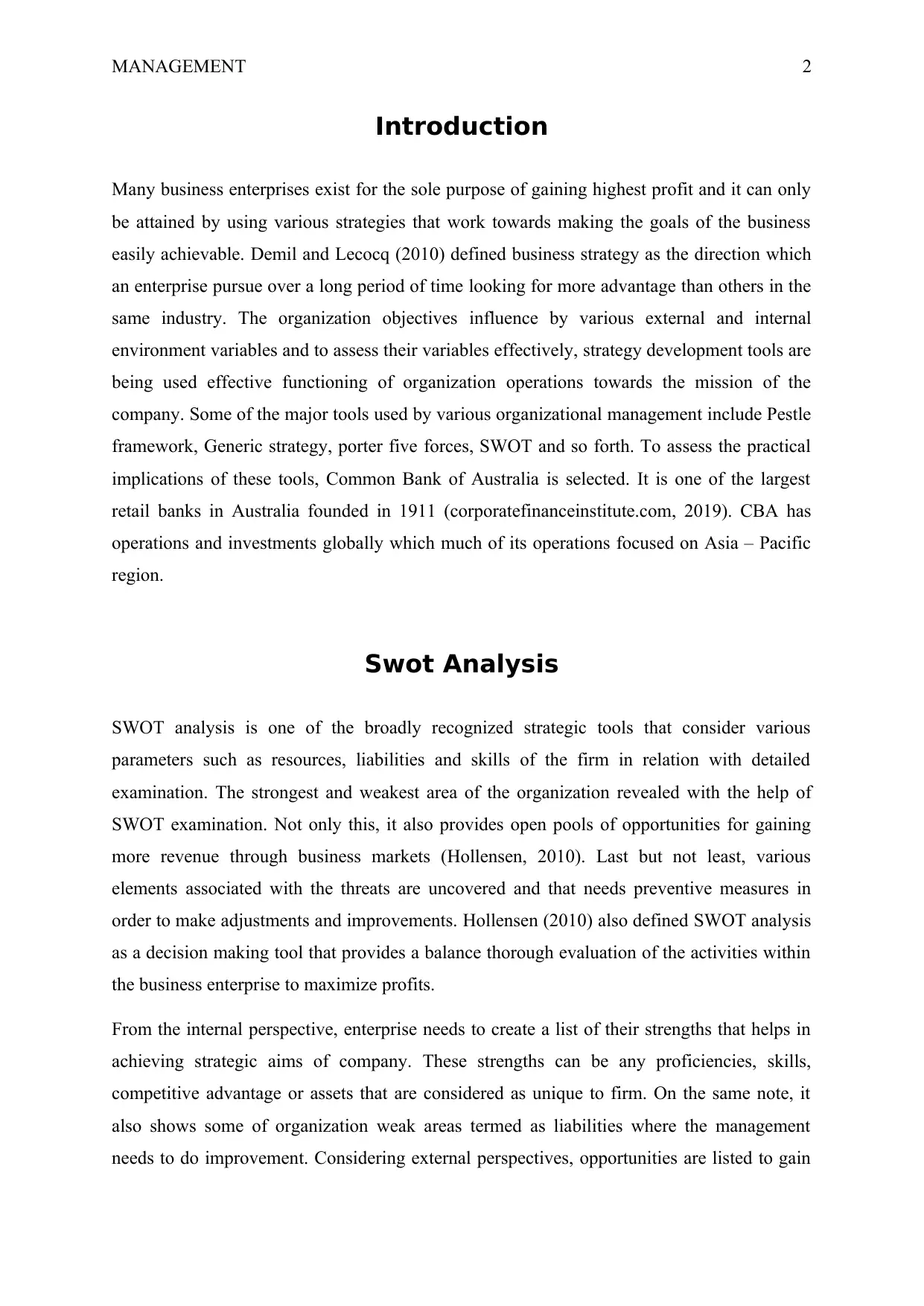
MANAGEMENT 2
Introduction
Many business enterprises exist for the sole purpose of gaining highest profit and it can only
be attained by using various strategies that work towards making the goals of the business
easily achievable. Demil and Lecocq (2010) defined business strategy as the direction which
an enterprise pursue over a long period of time looking for more advantage than others in the
same industry. The organization objectives influence by various external and internal
environment variables and to assess their variables effectively, strategy development tools are
being used effective functioning of organization operations towards the mission of the
company. Some of the major tools used by various organizational management include Pestle
framework, Generic strategy, porter five forces, SWOT and so forth. To assess the practical
implications of these tools, Common Bank of Australia is selected. It is one of the largest
retail banks in Australia founded in 1911 (corporatefinanceinstitute.com, 2019). CBA has
operations and investments globally which much of its operations focused on Asia – Pacific
region.
Swot Analysis
SWOT analysis is one of the broadly recognized strategic tools that consider various
parameters such as resources, liabilities and skills of the firm in relation with detailed
examination. The strongest and weakest area of the organization revealed with the help of
SWOT examination. Not only this, it also provides open pools of opportunities for gaining
more revenue through business markets (Hollensen, 2010). Last but not least, various
elements associated with the threats are uncovered and that needs preventive measures in
order to make adjustments and improvements. Hollensen (2010) also defined SWOT analysis
as a decision making tool that provides a balance thorough evaluation of the activities within
the business enterprise to maximize profits.
From the internal perspective, enterprise needs to create a list of their strengths that helps in
achieving strategic aims of company. These strengths can be any proficiencies, skills,
competitive advantage or assets that are considered as unique to firm. On the same note, it
also shows some of organization weak areas termed as liabilities where the management
needs to do improvement. Considering external perspectives, opportunities are listed to gain
Introduction
Many business enterprises exist for the sole purpose of gaining highest profit and it can only
be attained by using various strategies that work towards making the goals of the business
easily achievable. Demil and Lecocq (2010) defined business strategy as the direction which
an enterprise pursue over a long period of time looking for more advantage than others in the
same industry. The organization objectives influence by various external and internal
environment variables and to assess their variables effectively, strategy development tools are
being used effective functioning of organization operations towards the mission of the
company. Some of the major tools used by various organizational management include Pestle
framework, Generic strategy, porter five forces, SWOT and so forth. To assess the practical
implications of these tools, Common Bank of Australia is selected. It is one of the largest
retail banks in Australia founded in 1911 (corporatefinanceinstitute.com, 2019). CBA has
operations and investments globally which much of its operations focused on Asia – Pacific
region.
Swot Analysis
SWOT analysis is one of the broadly recognized strategic tools that consider various
parameters such as resources, liabilities and skills of the firm in relation with detailed
examination. The strongest and weakest area of the organization revealed with the help of
SWOT examination. Not only this, it also provides open pools of opportunities for gaining
more revenue through business markets (Hollensen, 2010). Last but not least, various
elements associated with the threats are uncovered and that needs preventive measures in
order to make adjustments and improvements. Hollensen (2010) also defined SWOT analysis
as a decision making tool that provides a balance thorough evaluation of the activities within
the business enterprise to maximize profits.
From the internal perspective, enterprise needs to create a list of their strengths that helps in
achieving strategic aims of company. These strengths can be any proficiencies, skills,
competitive advantage or assets that are considered as unique to firm. On the same note, it
also shows some of organization weak areas termed as liabilities where the management
needs to do improvement. Considering external perspectives, opportunities are listed to gain
⊘ This is a preview!⊘
Do you want full access?
Subscribe today to unlock all pages.

Trusted by 1+ million students worldwide
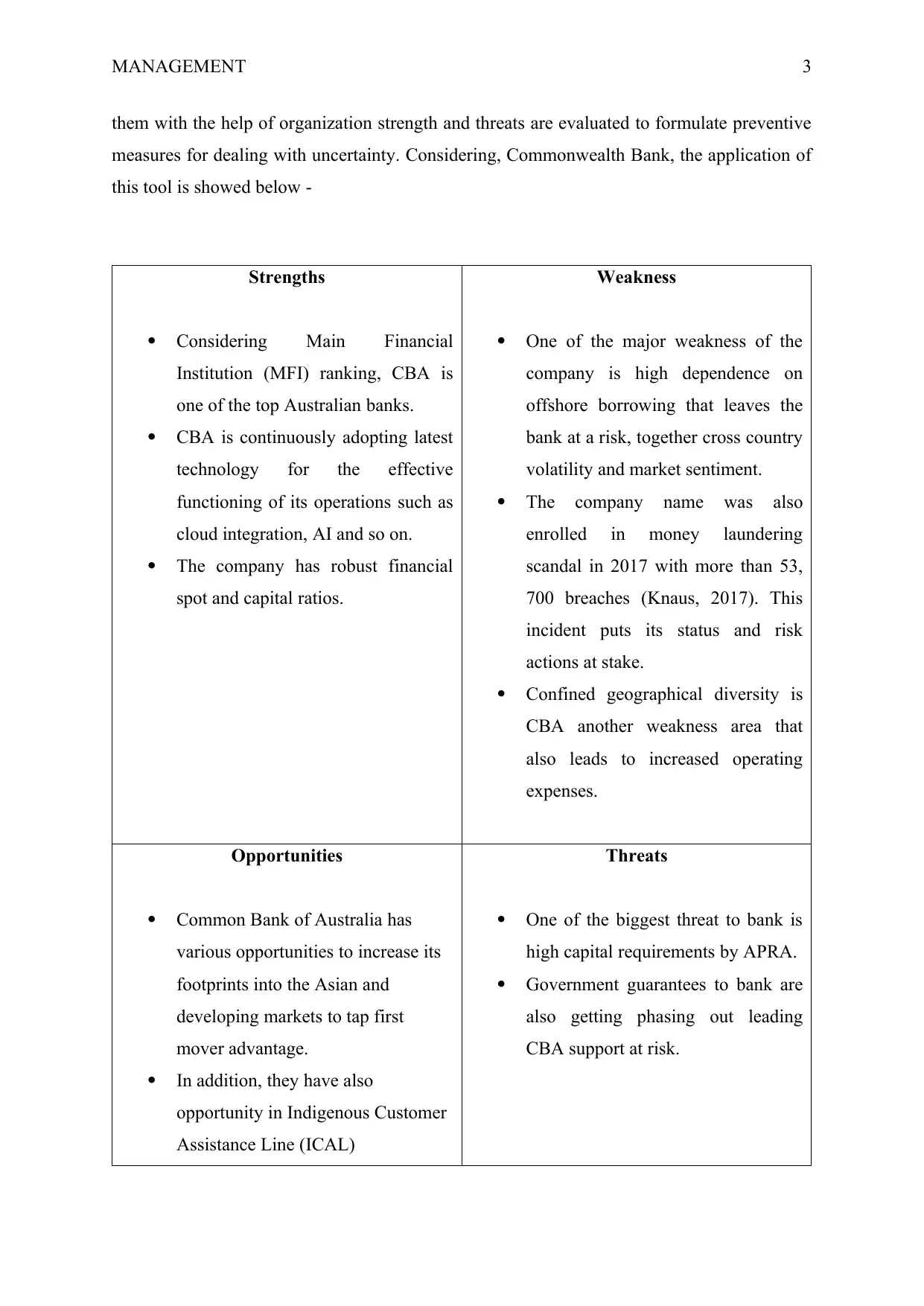
MANAGEMENT 3
them with the help of organization strength and threats are evaluated to formulate preventive
measures for dealing with uncertainty. Considering, Commonwealth Bank, the application of
this tool is showed below -
Strengths
Considering Main Financial
Institution (MFI) ranking, CBA is
one of the top Australian banks.
CBA is continuously adopting latest
technology for the effective
functioning of its operations such as
cloud integration, AI and so on.
The company has robust financial
spot and capital ratios.
Weakness
One of the major weakness of the
company is high dependence on
offshore borrowing that leaves the
bank at a risk, together cross country
volatility and market sentiment.
The company name was also
enrolled in money laundering
scandal in 2017 with more than 53,
700 breaches (Knaus, 2017). This
incident puts its status and risk
actions at stake.
Confined geographical diversity is
CBA another weakness area that
also leads to increased operating
expenses.
Opportunities
Common Bank of Australia has
various opportunities to increase its
footprints into the Asian and
developing markets to tap first
mover advantage.
In addition, they have also
opportunity in Indigenous Customer
Assistance Line (ICAL)
Threats
One of the biggest threat to bank is
high capital requirements by APRA.
Government guarantees to bank are
also getting phasing out leading
CBA support at risk.
them with the help of organization strength and threats are evaluated to formulate preventive
measures for dealing with uncertainty. Considering, Commonwealth Bank, the application of
this tool is showed below -
Strengths
Considering Main Financial
Institution (MFI) ranking, CBA is
one of the top Australian banks.
CBA is continuously adopting latest
technology for the effective
functioning of its operations such as
cloud integration, AI and so on.
The company has robust financial
spot and capital ratios.
Weakness
One of the major weakness of the
company is high dependence on
offshore borrowing that leaves the
bank at a risk, together cross country
volatility and market sentiment.
The company name was also
enrolled in money laundering
scandal in 2017 with more than 53,
700 breaches (Knaus, 2017). This
incident puts its status and risk
actions at stake.
Confined geographical diversity is
CBA another weakness area that
also leads to increased operating
expenses.
Opportunities
Common Bank of Australia has
various opportunities to increase its
footprints into the Asian and
developing markets to tap first
mover advantage.
In addition, they have also
opportunity in Indigenous Customer
Assistance Line (ICAL)
Threats
One of the biggest threat to bank is
high capital requirements by APRA.
Government guarantees to bank are
also getting phasing out leading
CBA support at risk.
Paraphrase This Document
Need a fresh take? Get an instant paraphrase of this document with our AI Paraphraser
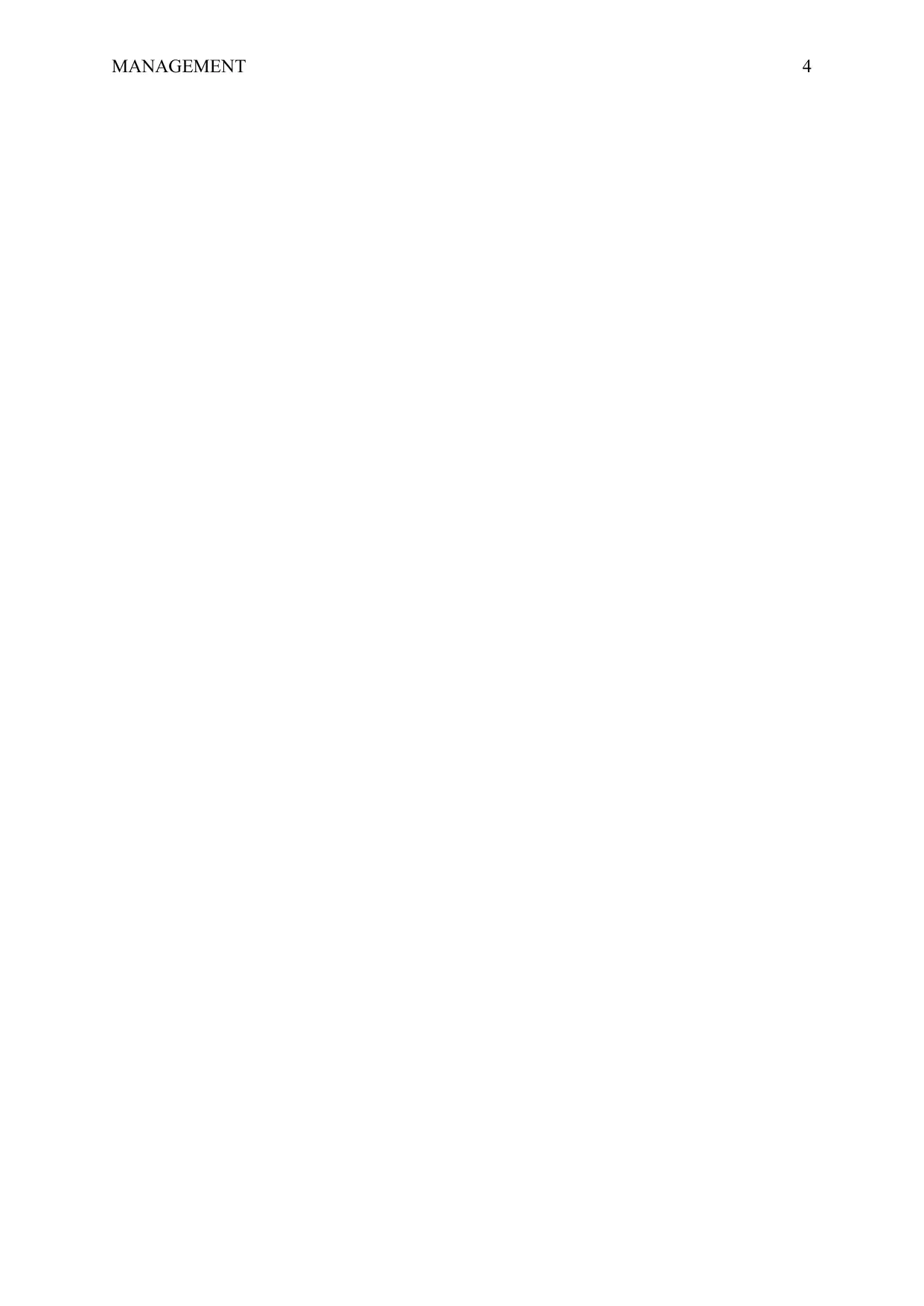
MANAGEMENT 4
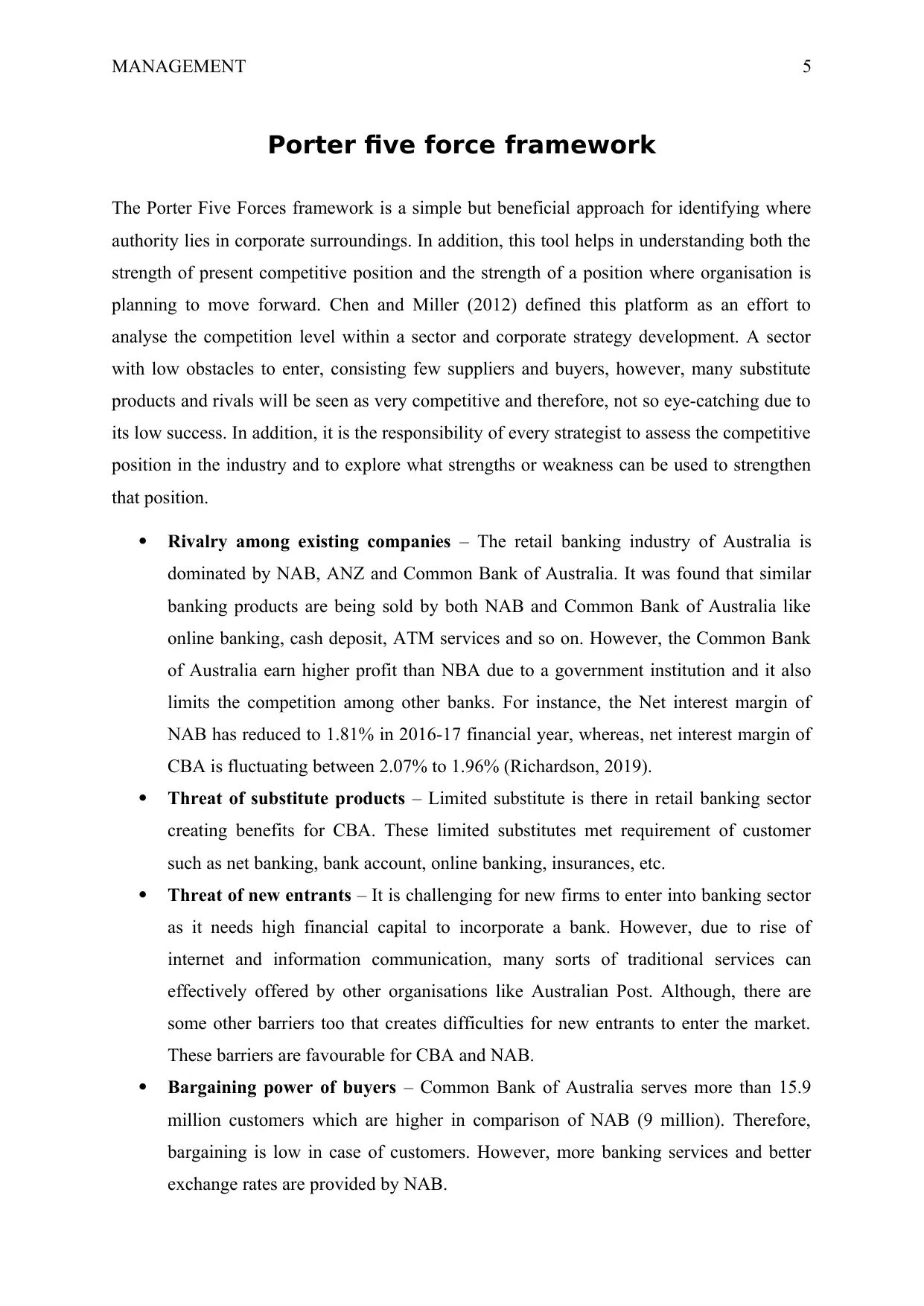
MANAGEMENT 5
Porter five force framework
The Porter Five Forces framework is a simple but beneficial approach for identifying where
authority lies in corporate surroundings. In addition, this tool helps in understanding both the
strength of present competitive position and the strength of a position where organisation is
planning to move forward. Chen and Miller (2012) defined this platform as an effort to
analyse the competition level within a sector and corporate strategy development. A sector
with low obstacles to enter, consisting few suppliers and buyers, however, many substitute
products and rivals will be seen as very competitive and therefore, not so eye-catching due to
its low success. In addition, it is the responsibility of every strategist to assess the competitive
position in the industry and to explore what strengths or weakness can be used to strengthen
that position.
Rivalry among existing companies – The retail banking industry of Australia is
dominated by NAB, ANZ and Common Bank of Australia. It was found that similar
banking products are being sold by both NAB and Common Bank of Australia like
online banking, cash deposit, ATM services and so on. However, the Common Bank
of Australia earn higher profit than NBA due to a government institution and it also
limits the competition among other banks. For instance, the Net interest margin of
NAB has reduced to 1.81% in 2016-17 financial year, whereas, net interest margin of
CBA is fluctuating between 2.07% to 1.96% (Richardson, 2019).
Threat of substitute products – Limited substitute is there in retail banking sector
creating benefits for CBA. These limited substitutes met requirement of customer
such as net banking, bank account, online banking, insurances, etc.
Threat of new entrants – It is challenging for new firms to enter into banking sector
as it needs high financial capital to incorporate a bank. However, due to rise of
internet and information communication, many sorts of traditional services can
effectively offered by other organisations like Australian Post. Although, there are
some other barriers too that creates difficulties for new entrants to enter the market.
These barriers are favourable for CBA and NAB.
Bargaining power of buyers – Common Bank of Australia serves more than 15.9
million customers which are higher in comparison of NAB (9 million). Therefore,
bargaining is low in case of customers. However, more banking services and better
exchange rates are provided by NAB.
Porter five force framework
The Porter Five Forces framework is a simple but beneficial approach for identifying where
authority lies in corporate surroundings. In addition, this tool helps in understanding both the
strength of present competitive position and the strength of a position where organisation is
planning to move forward. Chen and Miller (2012) defined this platform as an effort to
analyse the competition level within a sector and corporate strategy development. A sector
with low obstacles to enter, consisting few suppliers and buyers, however, many substitute
products and rivals will be seen as very competitive and therefore, not so eye-catching due to
its low success. In addition, it is the responsibility of every strategist to assess the competitive
position in the industry and to explore what strengths or weakness can be used to strengthen
that position.
Rivalry among existing companies – The retail banking industry of Australia is
dominated by NAB, ANZ and Common Bank of Australia. It was found that similar
banking products are being sold by both NAB and Common Bank of Australia like
online banking, cash deposit, ATM services and so on. However, the Common Bank
of Australia earn higher profit than NBA due to a government institution and it also
limits the competition among other banks. For instance, the Net interest margin of
NAB has reduced to 1.81% in 2016-17 financial year, whereas, net interest margin of
CBA is fluctuating between 2.07% to 1.96% (Richardson, 2019).
Threat of substitute products – Limited substitute is there in retail banking sector
creating benefits for CBA. These limited substitutes met requirement of customer
such as net banking, bank account, online banking, insurances, etc.
Threat of new entrants – It is challenging for new firms to enter into banking sector
as it needs high financial capital to incorporate a bank. However, due to rise of
internet and information communication, many sorts of traditional services can
effectively offered by other organisations like Australian Post. Although, there are
some other barriers too that creates difficulties for new entrants to enter the market.
These barriers are favourable for CBA and NAB.
Bargaining power of buyers – Common Bank of Australia serves more than 15.9
million customers which are higher in comparison of NAB (9 million). Therefore,
bargaining is low in case of customers. However, more banking services and better
exchange rates are provided by NAB.
⊘ This is a preview!⊘
Do you want full access?
Subscribe today to unlock all pages.

Trusted by 1+ million students worldwide
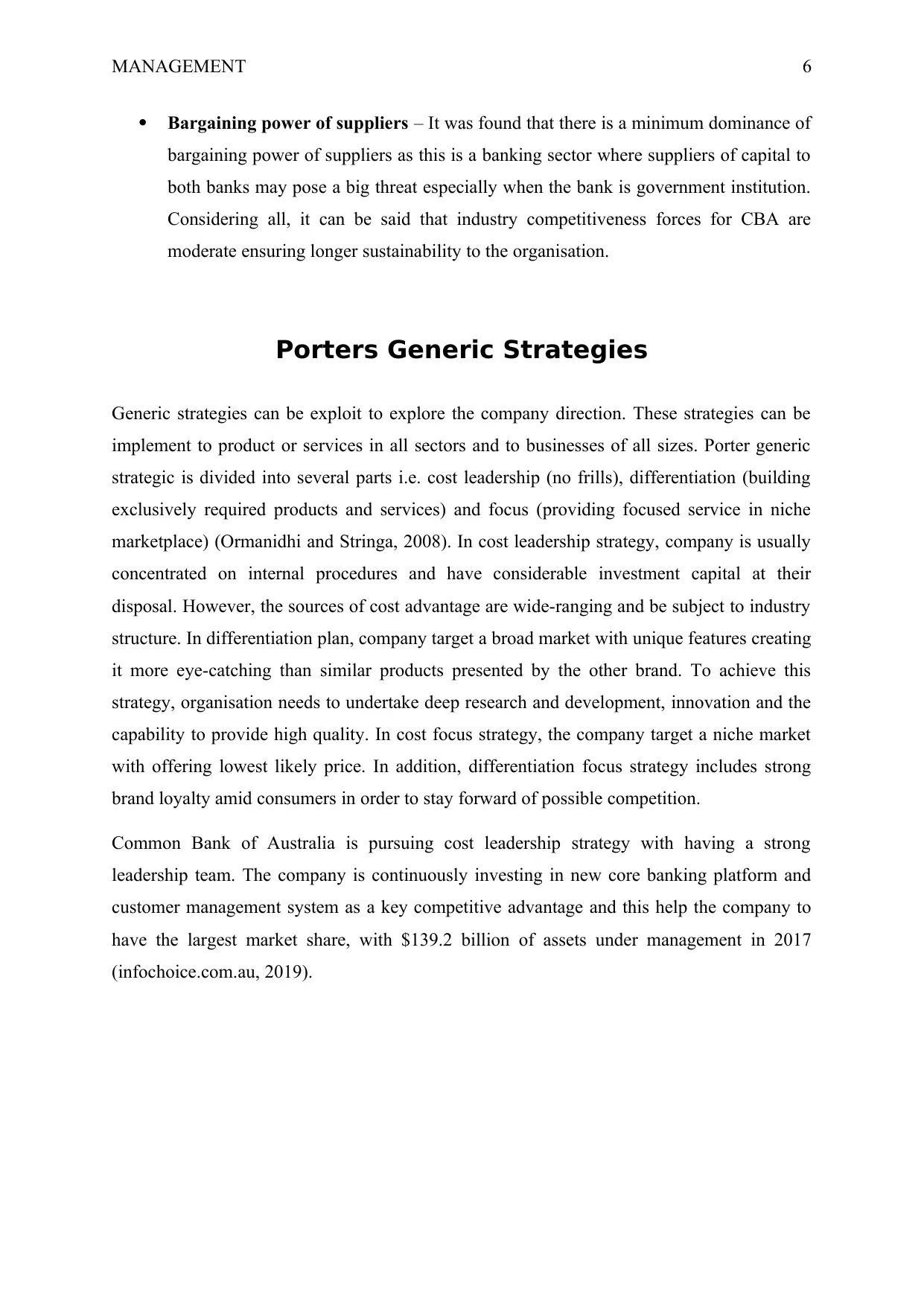
MANAGEMENT 6
Bargaining power of suppliers – It was found that there is a minimum dominance of
bargaining power of suppliers as this is a banking sector where suppliers of capital to
both banks may pose a big threat especially when the bank is government institution.
Considering all, it can be said that industry competitiveness forces for CBA are
moderate ensuring longer sustainability to the organisation.
Porters Generic Strategies
Generic strategies can be exploit to explore the company direction. These strategies can be
implement to product or services in all sectors and to businesses of all sizes. Porter generic
strategic is divided into several parts i.e. cost leadership (no frills), differentiation (building
exclusively required products and services) and focus (providing focused service in niche
marketplace) (Ormanidhi and Stringa, 2008). In cost leadership strategy, company is usually
concentrated on internal procedures and have considerable investment capital at their
disposal. However, the sources of cost advantage are wide-ranging and be subject to industry
structure. In differentiation plan, company target a broad market with unique features creating
it more eye-catching than similar products presented by the other brand. To achieve this
strategy, organisation needs to undertake deep research and development, innovation and the
capability to provide high quality. In cost focus strategy, the company target a niche market
with offering lowest likely price. In addition, differentiation focus strategy includes strong
brand loyalty amid consumers in order to stay forward of possible competition.
Common Bank of Australia is pursuing cost leadership strategy with having a strong
leadership team. The company is continuously investing in new core banking platform and
customer management system as a key competitive advantage and this help the company to
have the largest market share, with $139.2 billion of assets under management in 2017
(infochoice.com.au, 2019).
Bargaining power of suppliers – It was found that there is a minimum dominance of
bargaining power of suppliers as this is a banking sector where suppliers of capital to
both banks may pose a big threat especially when the bank is government institution.
Considering all, it can be said that industry competitiveness forces for CBA are
moderate ensuring longer sustainability to the organisation.
Porters Generic Strategies
Generic strategies can be exploit to explore the company direction. These strategies can be
implement to product or services in all sectors and to businesses of all sizes. Porter generic
strategic is divided into several parts i.e. cost leadership (no frills), differentiation (building
exclusively required products and services) and focus (providing focused service in niche
marketplace) (Ormanidhi and Stringa, 2008). In cost leadership strategy, company is usually
concentrated on internal procedures and have considerable investment capital at their
disposal. However, the sources of cost advantage are wide-ranging and be subject to industry
structure. In differentiation plan, company target a broad market with unique features creating
it more eye-catching than similar products presented by the other brand. To achieve this
strategy, organisation needs to undertake deep research and development, innovation and the
capability to provide high quality. In cost focus strategy, the company target a niche market
with offering lowest likely price. In addition, differentiation focus strategy includes strong
brand loyalty amid consumers in order to stay forward of possible competition.
Common Bank of Australia is pursuing cost leadership strategy with having a strong
leadership team. The company is continuously investing in new core banking platform and
customer management system as a key competitive advantage and this help the company to
have the largest market share, with $139.2 billion of assets under management in 2017
(infochoice.com.au, 2019).
Paraphrase This Document
Need a fresh take? Get an instant paraphrase of this document with our AI Paraphraser
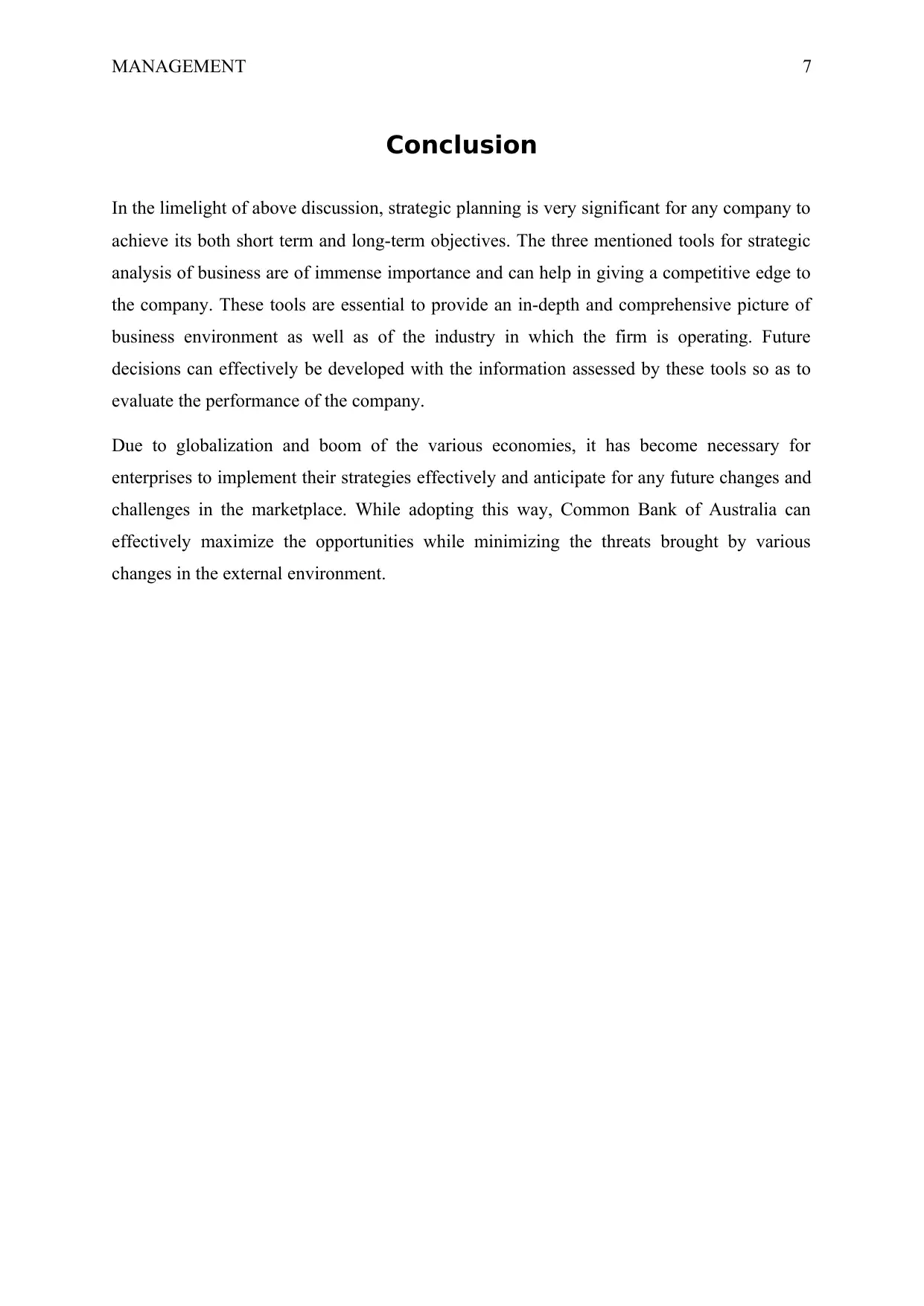
MANAGEMENT 7
Conclusion
In the limelight of above discussion, strategic planning is very significant for any company to
achieve its both short term and long-term objectives. The three mentioned tools for strategic
analysis of business are of immense importance and can help in giving a competitive edge to
the company. These tools are essential to provide an in-depth and comprehensive picture of
business environment as well as of the industry in which the firm is operating. Future
decisions can effectively be developed with the information assessed by these tools so as to
evaluate the performance of the company.
Due to globalization and boom of the various economies, it has become necessary for
enterprises to implement their strategies effectively and anticipate for any future changes and
challenges in the marketplace. While adopting this way, Common Bank of Australia can
effectively maximize the opportunities while minimizing the threats brought by various
changes in the external environment.
Conclusion
In the limelight of above discussion, strategic planning is very significant for any company to
achieve its both short term and long-term objectives. The three mentioned tools for strategic
analysis of business are of immense importance and can help in giving a competitive edge to
the company. These tools are essential to provide an in-depth and comprehensive picture of
business environment as well as of the industry in which the firm is operating. Future
decisions can effectively be developed with the information assessed by these tools so as to
evaluate the performance of the company.
Due to globalization and boom of the various economies, it has become necessary for
enterprises to implement their strategies effectively and anticipate for any future changes and
challenges in the marketplace. While adopting this way, Common Bank of Australia can
effectively maximize the opportunities while minimizing the threats brought by various
changes in the external environment.
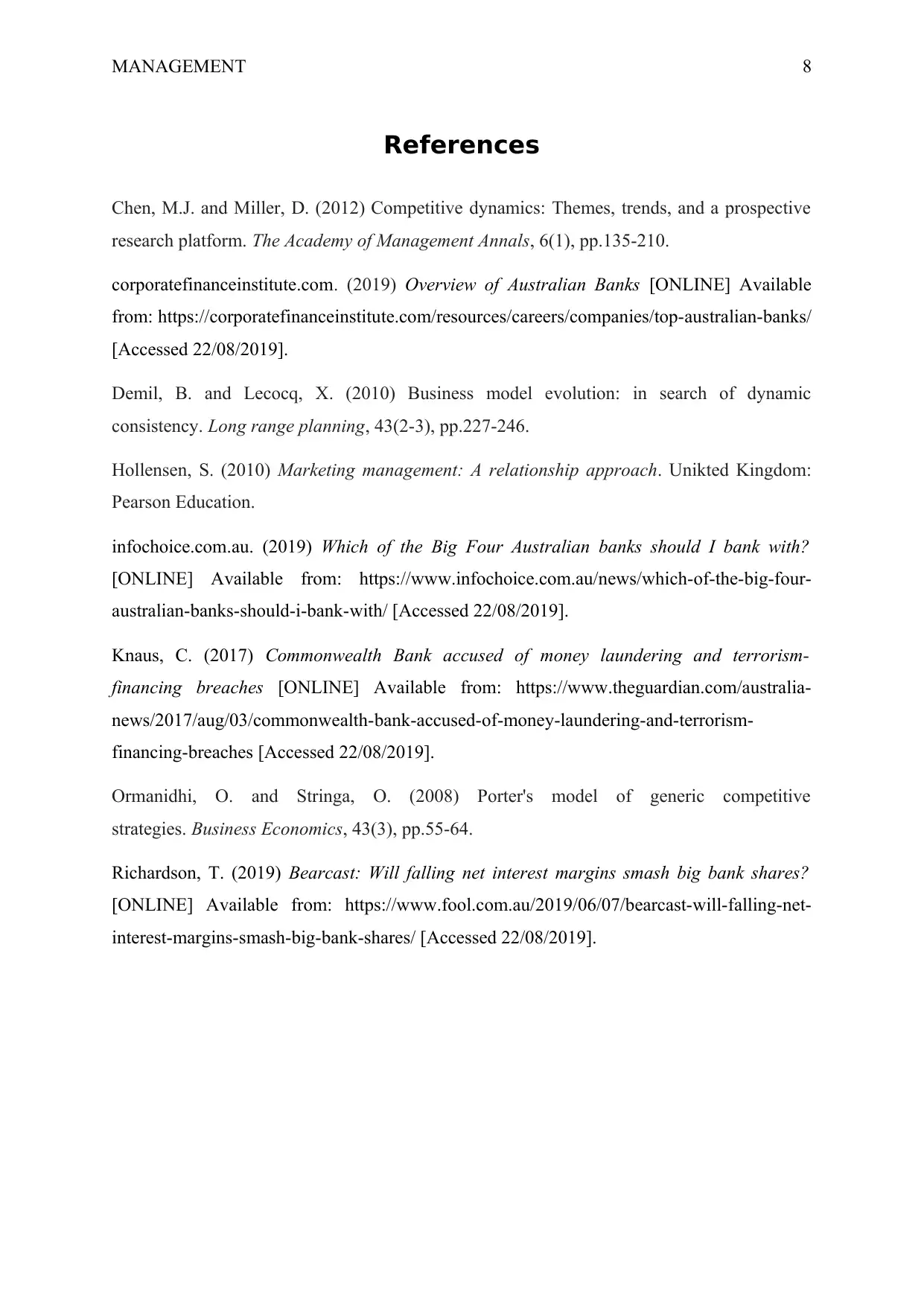
MANAGEMENT 8
References
Chen, M.J. and Miller, D. (2012) Competitive dynamics: Themes, trends, and a prospective
research platform. The Academy of Management Annals, 6(1), pp.135-210.
corporatefinanceinstitute.com. (2019) Overview of Australian Banks [ONLINE] Available
from: https://corporatefinanceinstitute.com/resources/careers/companies/top-australian-banks/
[Accessed 22/08/2019].
Demil, B. and Lecocq, X. (2010) Business model evolution: in search of dynamic
consistency. Long range planning, 43(2-3), pp.227-246.
Hollensen, S. (2010) Marketing management: A relationship approach. Unikted Kingdom:
Pearson Education.
infochoice.com.au. (2019) Which of the Big Four Australian banks should I bank with?
[ONLINE] Available from: https://www.infochoice.com.au/news/which-of-the-big-four-
australian-banks-should-i-bank-with/ [Accessed 22/08/2019].
Knaus, C. (2017) Commonwealth Bank accused of money laundering and terrorism-
financing breaches [ONLINE] Available from: https://www.theguardian.com/australia-
news/2017/aug/03/commonwealth-bank-accused-of-money-laundering-and-terrorism-
financing-breaches [Accessed 22/08/2019].
Ormanidhi, O. and Stringa, O. (2008) Porter's model of generic competitive
strategies. Business Economics, 43(3), pp.55-64.
Richardson, T. (2019) Bearcast: Will falling net interest margins smash big bank shares?
[ONLINE] Available from: https://www.fool.com.au/2019/06/07/bearcast-will-falling-net-
interest-margins-smash-big-bank-shares/ [Accessed 22/08/2019].
References
Chen, M.J. and Miller, D. (2012) Competitive dynamics: Themes, trends, and a prospective
research platform. The Academy of Management Annals, 6(1), pp.135-210.
corporatefinanceinstitute.com. (2019) Overview of Australian Banks [ONLINE] Available
from: https://corporatefinanceinstitute.com/resources/careers/companies/top-australian-banks/
[Accessed 22/08/2019].
Demil, B. and Lecocq, X. (2010) Business model evolution: in search of dynamic
consistency. Long range planning, 43(2-3), pp.227-246.
Hollensen, S. (2010) Marketing management: A relationship approach. Unikted Kingdom:
Pearson Education.
infochoice.com.au. (2019) Which of the Big Four Australian banks should I bank with?
[ONLINE] Available from: https://www.infochoice.com.au/news/which-of-the-big-four-
australian-banks-should-i-bank-with/ [Accessed 22/08/2019].
Knaus, C. (2017) Commonwealth Bank accused of money laundering and terrorism-
financing breaches [ONLINE] Available from: https://www.theguardian.com/australia-
news/2017/aug/03/commonwealth-bank-accused-of-money-laundering-and-terrorism-
financing-breaches [Accessed 22/08/2019].
Ormanidhi, O. and Stringa, O. (2008) Porter's model of generic competitive
strategies. Business Economics, 43(3), pp.55-64.
Richardson, T. (2019) Bearcast: Will falling net interest margins smash big bank shares?
[ONLINE] Available from: https://www.fool.com.au/2019/06/07/bearcast-will-falling-net-
interest-margins-smash-big-bank-shares/ [Accessed 22/08/2019].
⊘ This is a preview!⊘
Do you want full access?
Subscribe today to unlock all pages.

Trusted by 1+ million students worldwide
1 out of 9
Related Documents
Your All-in-One AI-Powered Toolkit for Academic Success.
+13062052269
info@desklib.com
Available 24*7 on WhatsApp / Email
![[object Object]](/_next/static/media/star-bottom.7253800d.svg)
Unlock your academic potential
Copyright © 2020–2025 A2Z Services. All Rights Reserved. Developed and managed by ZUCOL.




